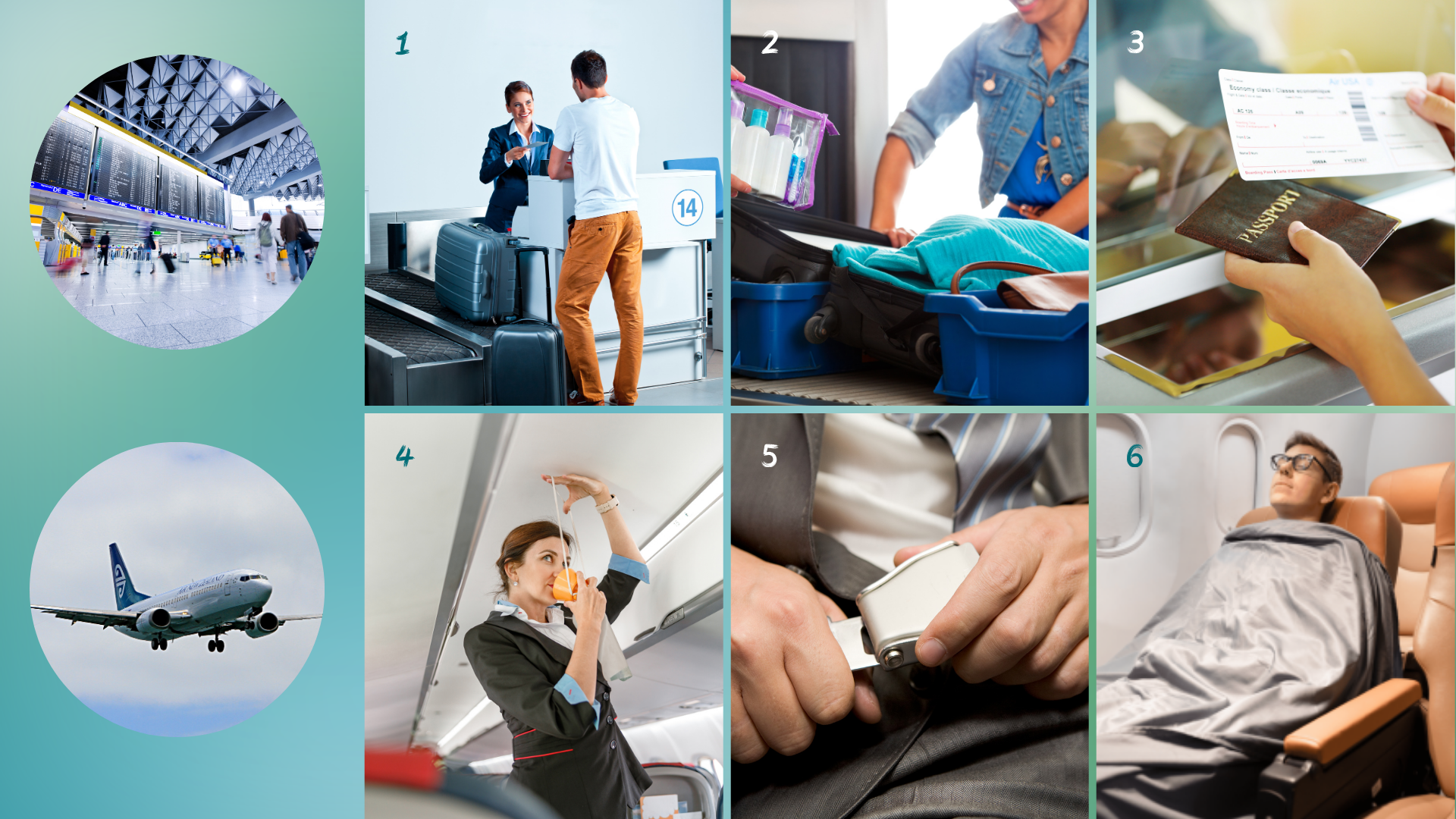Master essential Spanish airport and airplane vocabulary such as "facturar" (to check in), "tarjeta de embarque" (boarding pass), "control de seguridad" (security check), and expressions to ask about flight times and gates to travel confidently.
Listening and reading
Start this class by listening to the audio and completing the corresponding exercises.
Vocabulary (17) Share Copied!
Exercises Share Copied!
These exercises can be done together during conversation lessons or as homework.
Exercise 1: Translate and use in a sentence
Instruction: Pick a word, translated and use the word in a sentence or dialogue.
1
El pasaporte
The passport
2
Viajar en avión
To travel by plane
3
Ponerse cómodo
Make yourself comfortable
4
La tarjeta de embarque
The boarding pass
5
El carné de identidad
The identity card
Ejercicio 2: Conversation exercise
Instrucción:
- Con la ayuda de las imágenes describe lo que tienes que hacer en el aeropuerto y en el avión. (With the help of the pictures describe what you have to do in the airport and on the plane. )
- ¿Te gusta volar? ¿Por qué o por qué no? (Do you like to fly? Why or why not?)
Teaching guidelines +/- 10 minutes
Example phrases:
|
Tienes que obtener tu billete en el mostrador de facturación. You have to get your ticket at the check-in counter. |
|
Es necesario pasar por el control de seguridad. It is necessary to go through the security check. |
|
En el avión tienes que usar el cinturón de seguridad. In the plane you have to use your seatbelt. |
|
No me gusta volar porque el control de seguridad siempre tarda mucho. I don't like to fly because the security check takes always so long. |
|
Me gusta viajar en avión porque es muy rápido. I like going by plane because it is so fast. |
|
No me gustan los asientos del avión. No son cómodos. I don't like the airplane seats. They are not comfortable. |
|
El auxiliar de vuelo está mostrando las instrucciones de seguridad. The steward is showing the safety instructions. |
| ... |
Exercise 3: Dialogue Cards
Instruction: Select a situation and practice the conversation with your teacher or fellow students.
Exercise 4: Multiple Choice
Instruction: Choose the correct solution
1. Ya _____ pasado el control de seguridad y puedo mostrar mi tarjeta de embarque.
(I have already _____ passed the security check and I can show my boarding pass.)2. Ahora _____ mi pasaporte en el mostrador para facturar el equipaje.
(Now _____ my passport at the counter to check in the luggage.)3. El piloto _____ pasado todas las pruebas antes del vuelo.
(The pilot _____ passed all the tests before the flight.)4. Siempre _____ mi tarjeta de embarque antes de entrar al avión.
(I always _____ my boarding pass before entering the plane.)Exercise 5: At the airport: Security check and flight
Instruction:
Verb Tables
Pasar - Pasar
Pretérito perfecto
- yo he pasado
- tú has pasado
- él/ella/Ud. ha pasado
- nosotros hemos pasado
- vosotros habéis pasado
- ellos/ellas/Uds. han pasado
Mostrar - Mostrar
Presente
- yo muestro
- tú muestras
- él/ella/Ud. muestra
- nosotros mostramos
- vosotros mostráis
- ellos/ellas/Uds. muestran
Indicar - Indicar
Presente
- yo indico
- tú indicas
- él/ella/Ud. indica
- nosotros indicamos
- vosotros indicáis
- ellos/ellas/Uds. indican
Abrocharse - Abrocharse
Presente
- yo me abrocho
- tú te abrochas
- él/ella/Ud. se abrocha
- nosotros nos abrochamos
- vosotros os abrocháis
- ellos/ellas/Uds. se abrochan
Informar - Informar
Pretérito perfecto
- yo he informado
- tú has informado
- él/ella/Ud. ha informado
- nosotros hemos informado
- vosotros habéis informado
- ellos/ellas/Uds. han informado
Aterrizar - Aterrizar
Presente
- yo aterrizo
- tú aterrizas
- él/ella/Ud. aterriza
- nosotros aterrizamos
- vosotros aterrizáis
- ellos/ellas/Uds. aterrizan
Ponerse - Ponerse
Presente
- yo me pongo
- tú te pones
- él/ella/Ud. se pone
- nosotros nos ponemos
- vosotros os ponéis
- ellos/ellas/Uds. se ponen
Exercise 6: Adjectives: "Bonito", "Feo", "Bueno", "Malo", etc ...
Instruction: Fill in the correct word.
Grammar: Adjectives: "Bonito", "Feo", "Bueno", "Malo", etc ...
Show translation Show answersmalo, bonito, bueno, fuerte, débil
Grammar Share Copied!
It's not the most exciting thing, we admit, but it’s absolutely essential (and we promise it'll pay off)!
A2.4.2 Gramática
Adjectives: "Bonito", "Feo", "Bueno", "Malo", etc ...
Adjectives: "Bonito", "Feo", "Bueno", "Malo", etc ...
Verb conjugation tables for this lesson Share Copied!
Pasar to pass Share Copied!
Pretérito perfecto
| Spanish | English |
|---|---|
| (yo) he pasado | I have passed |
| (tú) has pasado | You have passed |
| (él/ella) ha pasado | he/she has passed |
| (nosotros/nosotras) hemos pasado | we have passed |
| (vosotros/vosotras) habéis pasado | You have passed |
| (ellos/ellas) han pasado | they have passed |
Mostrar show Share Copied!
Presente
| Spanish | English |
|---|---|
| (yo) muestro | I show |
| (tú) muestras | you show |
| (él/ella) muestra | he/she shows |
| (nosotros/nosotras) mostramos | we show |
| (vosotros/vosotras) mostráis | You show |
| (ellos/ellas) muestran | they show |
Don't see progress when learning on your own? Study this material with a certified teacher!
Do you want to practice Spanish today? That is possible! Just contact one of our teachers today.
Overview of the Lesson: At the Airport and in the Plane
This lesson focuses on essential Spanish vocabulary and phrases related to traveling through the airport and flying on an airplane. Designed for A2-level learners, it guides you through practical scenarios such as checking in luggage, asking for flight information, passing through security, and understanding basic in-flight instructions.
Key Topics Covered
- Check-in Procedures: Phrases for registering your luggage and confirming flights at the check-in counter.
Example: "Quisiera facturar mi maleta para el vuelo a Madrid." (I would like to check in my suitcase for the flight to Madrid.) - Flight Information Queries: How to ask about departure times, terminals, and boarding gates.
Example: "¿A qué hora sale el vuelo hacia Barcelona?" (What time does the flight to Barcelona depart?) - Security Check: Important instructions and vocabulary for passing through airport security smoothly.
Example: "Por favor, saque su pasaporte y su equipaje de mano." (Please take out your passport and carry-on luggage.) - Adjectives for Descriptions: Common adjectives such as "bonito" (nice), "feo" (ugly), "bueno" (good), and "malo" (bad) to describe experiences or objects in context.
Verb Practice and Grammar Highlights
The lesson incorporates useful verb conjugations in present and past tenses, particularly focusing on:
- Pretérito perfecto (present perfect) to describe completed actions recently done, e.g., "He pasado por el control de seguridad" (I have passed through security).
- Present tense verbs like "mostrar" (to show) and reflexive verbs such as "abrocharse" (to fasten oneself) and "ponerse" (to put on oneself).
Mini Story Summary
The included story narrates a traveler's experience moving through the airport and onto the plane, helping you see the vocabulary and grammar in natural context. It illustrates actions like showing a boarding pass, fastening a seatbelt, and the pilot announcing landing.
Important Linguistic Notes
Unlike English, Spanish uses reflexive verbs frequently to express actions done to oneself, such as "abrocharse" (to fasten oneself), which is essential in travel contexts for safety instructions. Also, Spanish makes much use of the present perfect tense (pretérito perfecto) to describe recent past actions, which in English often translates as simple past but with a subtle difference in nuance.
Useful phrases and their English approximations include:
- "¿Tiene su pasaporte?" – "Do you have your passport?"
- "Tarjeta de embarque" – "Boarding pass"
- "Puerta de embarque" – "Boarding gate"
- "Pasar el control de seguridad" – "To go through security check"
- "Me pongo cómodo" – "I make myself comfortable" (reflexive verb usage)
Understanding these patterns will help you communicate more naturally and follow procedures efficiently while traveling in Spanish-speaking countries.





























